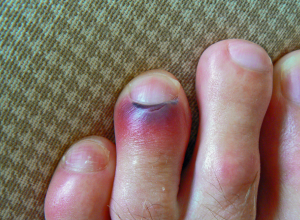
Chilblains
Chilblains (sometimes called pernio and perniosis) are localized areas of itchy, painful tissue inflammation. The swollen, purplish-reddish areas appear in response to repeated exposure to cold and/or damp conditions above the freezing point, specifically when the frozen area of skin is suddenly rewarmed.
Chilblains are often confused with frostbite and trench foot, two similar conditions.
Symptoms
Pernio generally affect the toes, fingers, nose and ears. Patients generally exhibit blisters, burning and itching in the affected area, skin redness and/or discoloration, dermatitis and ulcers on the digits.
Causes
Chilblains are a result of the capillary beds in the skin being damaged by repeated exposure to cold weather followed by sudden rewarming.
In rare cases, chilblains are a manifestation of other diseases, including lupus (a connective tissue disease). Some infants with Aicardi–Goutières syndrome also spontaneously develop chilblains.
Treatment
Chilblains take approximately one to two weeks to fully heal. Treatment typically includes keeping the area dry, warm and free from extreme temperature changes (both hot and cold). Topical steroids creams, friar’s balsam, iodine solutions, calcium and Vitamin D supplements may also help with irritation, pain and itchiness. A vasodilator called nifedipine may be administered in extreme cases.
If left untreated, chilblains may lead to infection. Anyone with poor circulation or a disease like diabetes, peripheral nerve damage and Raynaud’s phenomenon should seek medical treatment or make a dermatology appointment to avoid infection and further complications.
Prevention
Patients can avoid developing chilblains by avoiding extreme temperature changes, wearing clothing appropriate for weather conditions, avoiding tight and/or constricting clothing and footwear, and keeping circulation healthy with diet and regular exercise.
Notice concerning medical entries:
Articles having medical content shall serve exclusively for the purpose of general information. Such articles are not suitable for any (self-) diagnosis and treatment of individual illnesses and medical indications. In particular, they cannot substitute for the examination, advice, or treatment by a licensed physician or pharmacist. No replies to any individual questions shall be effected through the articles.






